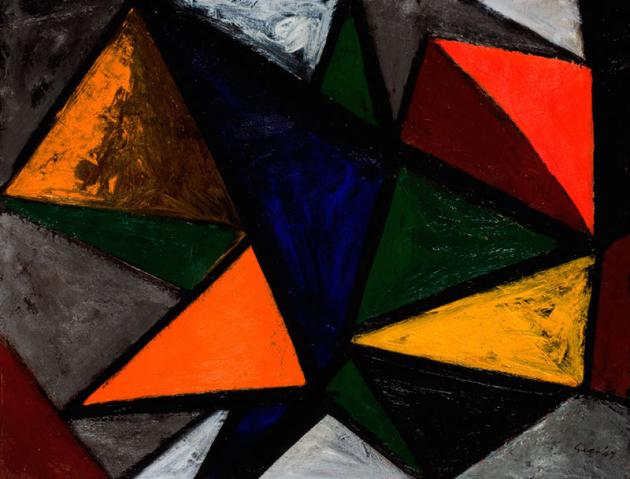For those of you who have never heard of William Gear, this an undervalued painter worth discovering! His is perhaps, the painter that Britain forgot. Now a new retrospective exhibition traces his influence and prolific output of a now little-known painter who was associated with CoBrA in the 1940s and produced some of the most radical and controversial compositions of the 1950s. The exhibition draws together over 100 works representing the different phases of Gear’s oeuvre.
From quite early in his career Gear demonstrated a fondness for heavy black line as a division of colour – predominantly reds, yellows and oranges. He acknowledged that this probably derived in part from his childhood – subconscious memories of the pit-head winding gear and the engineering marvel of the Forth Bridge. He regarded structure – the architecture, like a building, the scaffolding as the most essential basis of his painting.
William Gear was born in Fife, Scotland, on 2 August 1915, the son of Janet Gear and Porteous Gear, a coal miner. He studied at Edinburgh College of Art from 1932-6, gaining a postgraduate scholarship that enabled him to study art at Edinburgh University from 1936-7. Winning a travelling scholarship enabled him to visit Italy, Greece, and the Balkans and to study in Paris with Fernand Leger.
Gear served throughout the Second World War as an officer in the Royal Corps of Signals including a stint with the ‘Monuments Men’. In 1947, he settled in Paris where he met many of the leading post-war Parisian artists. After meeting Appel, Constant, Corneille and Jorn, he joined the CoBrA group, Europe’s most important avant-garde movement of the mid – twentieth century. CoBrA is an acronym based on Copenhagen, Brussels and Amsterdam in acknowledgement of the founders’ nationalities and to emphasise the internationalism of their attitude.
The CoBrA painters emphasised spontaneity – an image, they felt, should appear on the canvas as naturally and quickly as a sudden change of weather in the world beyond the window. And it ought to be as impersonal as a thunderstorm.
William Gear exhibited with the group in Amsterdam and Copenhagen in 1949; however, beyond his association with CoBrA he had a long and successful career in his own right. For example, he was awarded a Festival of Britain Purchase Prize in 1951 and his work appeared at the 1954 Venice Biennale.
Gear was Towner’s curator from 1958 until 1964. During this time, he added to the diversity and modernity of the permanent Collection with his acquisitions. These included paintings by major British Abstract artists of the 1950s and 1960s, such as Sandra Blow, Alan Davie, Roger Hilton and Ceri Richards, and prints by both young and established printmakers. So successful was he in increasing the reputation of Towner, that in 1962 the Observer newspaper hailed it as the ‘most go-ahead municipal gallery of its size in the country’. He became a Senior Royal Academician in 1995. His work is held in many major public and private collections around the world.
A beautifully illustrated catalogue has been published by the Redfern Gallery to accompany the exhibition.
Image: William Gear, Composition Blue Centre, 1949 Courtesy Towner gallery Eastbourne

